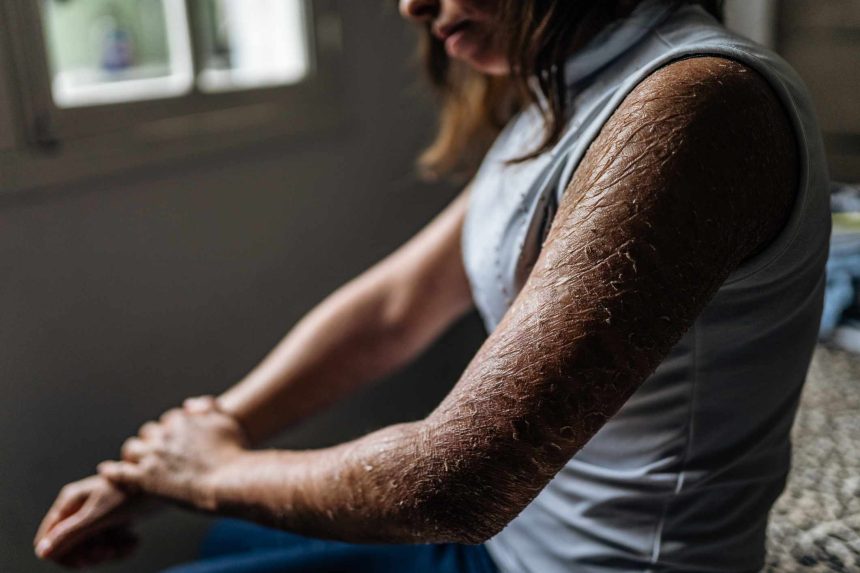Ichthyosis is a condition that causes your skin to become dry, thick, itchy, red, or cracked. Its name comes from the Greek word ichthy, meaning fish, as the affected skin may resemble fish scales.
The symptoms occur because the skin barrier doesn’t work properly, leading to too much moisture loss and extra skin growth. The condition is often inherited, with symptoms appearing at birth or early childhood. However, some people get ichthyosis and develop symptoms later in life due to another health condition or medication.
With ichthyosis, skin cells build up too fast and lose moisture, causing common skin symptoms such as:
- Dry, flaky, scaly skin
- Itching or discomfort
- Cracking, especially in areas that bend or stretch
- Erythema (redness and irritation)
- Hyperkeratosis (skin thickening)
Skin flakes or scales can be thin and fall off easily, or they may be thicker, darker, and more likely to stick to the skin. These scales may appear white, gray, or brown.
There are about 30 types of ichthyosis that differ in the appearance of scales, symptom severity, and inheritance patterns. General symptoms for each type may include:
- Blisters
- Keratosis pilaris (bumpy skin)
- Difficulty closing your eyelids
- Extra lines on your palms and soles
- Hearing difficulties from thick skin narrowing the ear canals
- Infections
- Overheating because scales block sweat glands
- Stiffness
- Hair loss or thinning
Ichthyosis Vulgaris Symptoms
Ichthyosis vulgaris is the most common type, affecting about 1 in every 100-250 people and accounting for about 95% of ichthyosis cases. Symptoms often appear in infancy, with most children showing signs by age 5. This type is usually mild, causing dry, flaky skin and fine, white scales that shed easily.
X-Linked Ichthyosis Symptoms
X-linked ichthyosis mainly affects males, starting around 3-6 months of age. The scales are larger and darker than milder forms like ichthyosis vulgaris, leading to discomfort as the condition worsens over time. The scales may be brown and polygon-shaped, affecting the body, legs, lower face, and neck.
Harlequin Ichthyosis Symptoms
Harlequin ichthyosis is a rare and severe type, affecting about 1 in 300,000 newborns. It causes thick, hard skin that cracks and creates plate-like patches over the whole body, making it hard for babies to breathe, move, and stay warm. Newborns with this type may also have a flattened nose or ectropion (eyelids that turn outward).
These newborns are at high risk for breathing problems, dehydration, and infections, requiring intensive care in a neonatal unit. Most babies do not survive beyond the first week, though survival with intense care can range from 10 months to 25 years.
Epidermolytic Ichthyosis Symptoms
Epidermolytic ichthyosis occurs at birth and causes fragile skin that easily forms blisters, sometimes covering large areas. The blisters heal over time, but thick, scaly skin appears, especially around joints like your elbows and knees. This can be painful, and the skin may crack over time.
Lamellar Ichthyosis Symptoms
Lamellar ichthyosis begins at birth, often with a tight, transparent layer known as a collodion membrane covering the entire body. This membrane peels away within weeks, revealing large, dark scales covering most of the body. The tight skin can cause discomfort and make it difficult for infants to move their limbs.
Nonbullous Congenital Ichthyosiform Erythroderma (NBCIE) Symptoms
Babies with nonbullous congenital ichthyosiform erythroderma (NBCIE) are often born with a tight, shiny membrane on their skin that can pull at the skin around their lips and eyelids. This membrane usually comes off within the first few weeks, leaving behind red skin covered with fine, white scales. These scales are generally smaller than those in other types but can still cover large areas, causing discomfort and difficulty moving.
Some babies with NBCIE have palmoplantar keratoderma (thickened skin on their hands and feet), little or no sweating, and unusual nails. Severe cases can include hair loss on the scalp and eyebrows. Symptoms often improve with age, and most people with NBCIE have an average life expectancy.
Erythrokeratodermia Variabilis Symptoms
Erythrokeratodermia variabilis causes rough, thick, or red patches on the face, buttocks, or limbs, which can spread to other areas over time. The condition typically appears a few months after birth and worsens during childhood.
Progressive Symmetric Erythrokeratoderma Symptoms
Progressive symmetric erythrokeratoderma usually begins in childhood and presents with dry, red, and scaly skin. It mainly affects the limbs, buttocks, face, ankles, and wrists, often leading to discomfort and restricted movement as the skin thickens.
Ichthyosis is not contagious and cannot be spread through touch or close contact. Most cases are genetic and involve over 50 genes that affect how the skin grows, sheds, and protects itself.
You can inherit ichthyosis from one or both parents, or it may occur randomly without a family history. Symptoms usually appear in infancy or childhood, but some cases can develop later in life due to triggers like certain health conditions or medications.
Applying moisturizer twice a day may take care of most dry, scaly skin that isn’t caused by ichthyosis or other skin conditions. If moisturizing doesn’t resolve your symptoms, consider talking to a healthcare provider to determine if you have ichthyosis.
If you or someone you care for already has ichthyosis, it’s important to know when to contact a healthcare provider. While ichthyosis is not life-threatening, some symptoms might need medical attention to prevent discomfort or infection. These include:
- Constant or worsening itching or discomfort
- Redness, warmth, swelling, or pus
- Skin that has a bad smell
- Trouble staying cool or getting overheated often
While there’s no cure for ichthyosis, environmental changes, skincare routines, and medical treatments can help reduce dryness and scaling. For people who get ichthyosis from an underlying health condition or medication, treating that issue can improve ichthyosis, so it can help to talk to your healthcare provider.
Ichthyosis is a skin disorder that causes dry, scaly skin. Symptoms usually begin in infancy or early childhood but can also appear later in life due to triggers like underlying illnesses or medication side effects.
There are about 30 types of ichthyosis that may each cause slightly different symptoms, which can range from mild to severe.
Depending on the type and severity, symptoms might include dry, flaky skin that itches, cracks, appears red, or forms blisters. The scales may appear thin and white or thick and darker in color.






